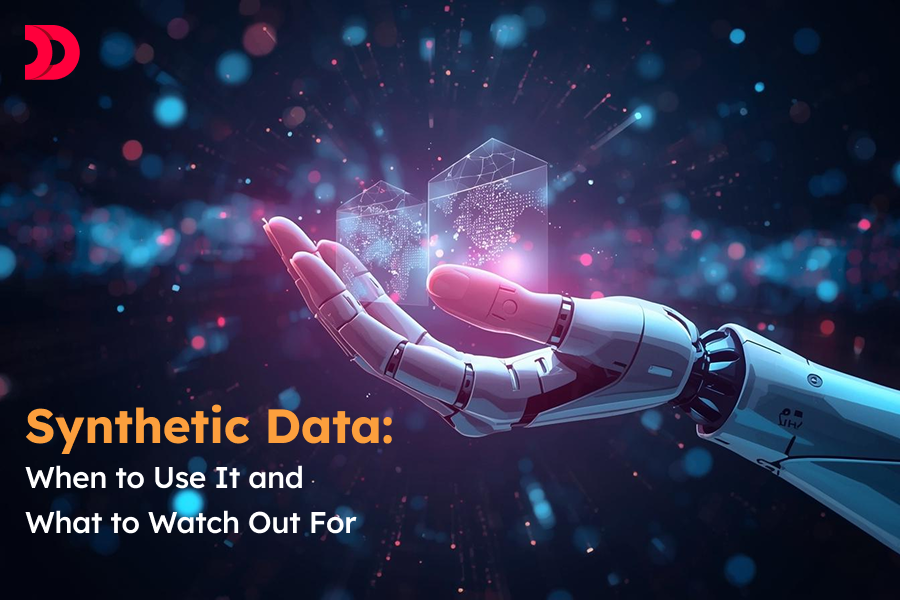5 Uses of OpenAI in Business Data Analysis
As technology continues to develop at a rapid pace, businesses are finding new and innovative ways to analyze and use data to make smarter decisions. One of the most exciting... Continue Reading

Let’s face it. Because the foundation of artificial intelligence depends entirely on real-world data, it introduces critical vulnerabilities. Moreover, regulations such as GDPR make it difficult to access and share sensitive information, thereby preventing innovation in highly regulated industries like finance. It is also impossible to capture actual data for rare events, and historical data may reflect societal biases. All these result in discrimination of AI systems, and it is challenging to make them fair.
Here, synthetic data emerges as a game-changer. It can mirror the statistical properties and complexity of real-world information without containing any identifiable data points. As a robust approach, synthetic data can enable developers to bypass privacy concerns. Developers can generate massive volumes of high-fidelity data where real samples are not available. This blog talks about the top benefits and possible risks of using synthetic data.
Let’s start with the introduction of synthetic data.
Synthetic data is information that algorithms have generated. It has no relation to real-world events, but it maintains both the mathematical and statistical properties of the original datasets. As it is fabricated data, it has no direct link to any individuals or records. This fact makes synthetic data inherently private and compliant with prevalent regulations.
Synthetic data can serve as a high-fidelity proxy for real data in applications, machine learning model training, and system testing. Usually, this data relies on three core methods- simulation, Generative Adversarial Networks (GANs), and statistical modeling. The GAN method is the most advanced one for creating synthetic data.
Synthetic data can play a vital role in assisting developers to get rid of two primary hurdles- data scarcity and confidentiality. When it comes to highly regulated sectors like finance and healthcare, privacy restrictions (like HIPAA and GDPR) prevent the transfer and usage of sensitive information about people.
In such a scenario, synthetic datasets provide a non-identifiable, statistically representative alternative. This data enables organizations to maintain compliance while training models and continuing to innovate. Furthermore, synthetic data allows engineers to overcome the challenge of rare events. Let’s take an example.
Waiting for critical instances like sophisticated fraud or catastrophic system failures to occur naturally is not feasible. Here, synthetic data makes it possible by instantly generating thousands of high-fidelity, artificial examples. It facilitates models to get trained even under extreme, hard-to-capture conditions.
Apart from this, synthetic data is inevitable for rigorous model testing and validation. When deploying AI in safety-critical areas, such as industrial robotics or autonomous vehicles, it is essential to stress-test the system. Synthetic data allows developers to create controlled environments to repeat and analyze specific, complex scenarios without the danger of real-world testing.
Finally, synthetic data can help balance imbalanced datasets to promote fairness. Real-world data often reflects historical biases or natural imbalances. It results in poorly performing AI models with discrimination against underrepresented groups. Synthetic data corrects skewed distributions, improving the model’s overall predictive performance across all segments.
One of the most important benefits of synthetic data is its excellent scalability with cost-saving capability. Unlike expensive real-world data collection, synthetic data needs only computational power. After getting training, the generative model can produce vast quantities of diverse, high-fidelity data points instantly. ,
Companies can scale their datasets from hundreds to millions quickly using synthetic data. This eliminates the need for expensive field collection, manual data labeling, and the logistical hurdles of collecting data from remote places. This acceleration reduces months off development cycles for reducing the total cost of ownership.
The other major advantages are enhanced privacy and improved dataset diversity. Because synthetic data contains no direct mappings to real people or actual events, it inherently protects sensitive information. This characteristic makes it the ideal solution for adhering to stringent data governance mandates worldwide.
This unlocks collaborative possibilities across different departments within an organization as well. They can share statistically representative data without exposing confidential details. Furthermore, synthetic data assists engineers in augmenting their datasets to create scenarios that are currently underrepresented.
Simply put, synthetic data can enhance the fairness of AI models and prepare them to handle a wide array of real-world inputs.
Though synthetic data offers big benefits, it is essential to keep some aspects in mind regarding three major risks. The first risk is the absence of realism and the failure to capture subtle complexity nuances. Although generative models strive for statistical fidelity, they may overlook the intricate, non-obvious correlations present in genuine observations.
Here is the catch. If the generative model is trained on insufficient or poorly pre-processed real data, the resulting synthetic output can be deceptively clean. Such output can miss the critical messiness of the real world. This can lead to models that perform excellently in the testing environment but fail miserably when exposed to real-world deployment.
The second risk is the danger of propagating hidden biases and introducing overfitting risks. If the real dataset contains discriminatory biases, the generative model will reproduce and potentially amplify these flaws in the synthetic output. Developers must, therefore, employ debiasing techniques. Furthermore, it is essential to check whether the generative model is too powerful.
The final major risk is misalignment with real production data, known as model drift. Today’s synthetic data might accurately mimic the real data used for training, but production environments constantly evolve. New customer behaviors or environmental changes can cause the real data streaming into the deployed system to diverge from the initial synthetic distribution.
Companies can address these challenges or risks by hiring a reputable synthetic data solution provider. Let’s delve into the best practices to leverage the benefits of synthetic data.
A hybrid approach is the best practice for maximizing the efficacy of synthetic data. This approach involves the method of using real data to train the foundational model and then injecting synthetic data into it. This is specifically necessary to handle data scarcity, balance class imbalances, and rigorously test edge cases. This combination ensures that the model benefits from the statistical truth of real data while gaining the resilience of the synthetic dataset.
Other best practices for ensuring successful deployment include rigorous validation and monitoring for drift. Engineers must compare model performance on the synthetic testing set against its performance on fresh production data continuously. This can ensure that the synthetic proxy remains in line with the evolving real-world environment.
An ecosystem of specialized platforms can assist developers in following these best practices. Tools like Gretel and Mostly AI provide enterprise-grade solutions for generating high-fidelity, privacy-preserving synthetic datasets. Synthesis AI specializes in generating photorealistic images and videos for training visual perception models used in robotics and autonomous systems. Additionally, open-source solutions like Synthea and Unity SynthDet are useful to generate diverse urban images and annotated synthetic image data.
Synthetic data brings a fundamental shift, keeping AI development away from real-world data scarcity and privacy concerns. This robust concept accelerates innovation and allows for the creation of more unbiased models. However, companies should focus on several considerations and ensure responsible use while leveraging the benefits of synthetic data.
Frequently Asked Questions Synthetic data is primarily used for training AI or ML models and enabling privacy-compliant data sharing. No, synthetic data cannot replace real data entirely. It can, however, dramatically augment and scale datasets. Real data remains necessary for critical validation. The accuracy of synthetic data depends on the generation method; however, high-quality synthetic data is designed to retain the same statistical properties as real data. FAQ's
As technology continues to develop at a rapid pace, businesses are finding new and innovative ways to analyze and use data to make smarter decisions. One of the most exciting... Continue Reading
Feel free to call or visit us anytime; we strive to respond to all inquiries within 24 hours.
